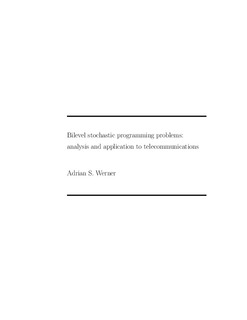| dc.contributor.advisor | Gaivoronski, Alexei | nb_NO |
| dc.contributor.author | Werner, Adrian | nb_NO |
| dc.date.accessioned | 2014-12-19T14:24:50Z | |
| dc.date.available | 2014-12-19T14:24:50Z | |
| dc.date.created | 2005-04-08 | nb_NO |
| dc.date.issued | 2005 | nb_NO |
| dc.identifier | 125664 | nb_NO |
| dc.identifier.isbn | 82-471-6975-4 | nb_NO |
| dc.identifier.uri | http://hdl.handle.net/11250/264997 | |
| dc.description.abstract | We analyse several facets of bilevel decision problems under uncertainty. These problems can be interpreted as an extension of stochastic programming problems where part of the uncertainty is attributed to the behaviour of another actor.
The field of decision making under uncertainty with bilevel features is quite new and most approaches focus on the interactions and relations between the decision makers. In contrast to these studies, the approach of bilevel stochastic programming pursued here stresses the stochastic programming aspect of the problem formulation. The framework enables a direct application of stochastic programming concepts and solution methods to the bilevel relationship between the actors. Thus more complex problem structures can be studied and the aspect of uncertainty can be treated adequately.
Our analysis covers both theoretical and more practically oriented issues. We study different formulations of one and two stage bilevel stochastic programming problems and state necessary optimality conditions for each of the problem instances. Additionally we present a solution algorithm utilising a stochastic quasi-gradient method. A further study is concerned with the uniqueness of the minima of a convex stochastic programming problem with uncertainty about the decision variables. We state conditions on the distribution of the parameters representing the uncertainty such that the minima of the optimisation problem are unique. We formulate a model of competition and collaboration of two different types of telecom service providers, the owner of a bottleneck facility and a virtual network operator. This represents an application of a bilevel stochastic programming formulation to a liberalised telecommunications environment. Furthermore, the utilisation of the bilevel stochastic programming framework and the developed solution concepts for the analysis of principal agent models is demonstrated. Also here the background of a regulated telecom environment, more specific the relations between a regulator and a regulated telecommunications company, was chosen. | nb_NO |
| dc.language | eng | nb_NO |
| dc.publisher | Fakultet for samfunnsvitenskap og teknologiledelse | nb_NO |
| dc.relation.ispartofseries | Doktoravhandlinger ved NTNU, 1503-8181; 2005:53 | nb_NO |
| dc.relation.haspart | Werner, Adrian S.; Gaivoronski, Alexei A.. Utilisation of stochastic programming methods for the analysis of agency problems. . | nb_NO |
| dc.relation.haspart | Werner, Adrian S.; Gaivoronski, Alexei A.. Influence of perturbed input data on convexity properties of stochastic programming problems. . | nb_NO |
| dc.subject | Mathematical optimization, systems theory | en_GB |
| dc.subject | Stochastic programming | en_GB |
| dc.subject | principal agent problem | en_GB |
| dc.subject | bilevel optimization | en_GB |
| dc.subject | telecommunications | en_GB |
| dc.subject | MATHEMATICS: Applied mathematics: Optimization, systems theory | en_GB |
| dc.title | Bilevel stochastic programming problems: Analysis and application to telecommunications | nb_NO |
| dc.type | Doctoral thesis | nb_NO |
| dc.source.pagenumber | 165 | nb_NO |
| dc.contributor.department | Norges teknisk-naturvitenskapelige universitet, Fakultet for samfunnsvitenskap og teknologiledelse | nb_NO |
| dc.description.degree | dr.ing. | nb_NO |
| dc.description.degree | dr.ing. | en_GB |
